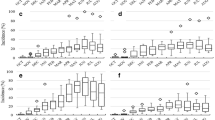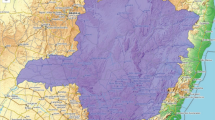Abstract
We developed models for simulating trends over time as functions of the thermal index and models for estimating the levels of infestation of the coffee leaf miner and coffee berry borer and the severity of disease for coffee leaf rust and cercospora, the main phytosanitary problems in coffee crops around the world. We used historical series of climatic data and levels of pest infestation and disease severity in Coffea arabica for high and low yields for seven locations in the two main coffee-producing regions in the state of Minas Gerais in Brazil, Sul de Minas Gerais and Cerrado Mineiro. We conducted two analyses: (a) we simulated the trends of the progress of diseases and pests over time using non-linear models. We only used the thermal index because air temperature is commonly measured by farmers in the regions. (b) We estimated the levels of pest infestation and disease severity using multiple linear regression, with the levels of diseases and pests as dependent variables and accumulated degree days (DD), coffee foliage (LF) estimated by DD and the number of nodes (NN) estimated by DD as independent variables. We used DD and LF = f (DD) and NN = f (DD) to predict diseases and pests with accuracy. MAPEs were 19.6, 5.7, 9.5, and 15.8% for rust, cercospora, leaf miner, and berry borer, respectively, for Sul de Minas Gerais. Establishing phytosanitary alerts using only air temperature was possible with these models.














Similar content being viewed by others
References
Abedeta C, Getu E, Seyoum E, Hindorf H, Berhane T (2015) Coffee leaf damaging insects occurrence in the forest coffee ecosystem of southwestern Ethiopia. African J Plant Sci 9(2):75–81
Allinne C, Savary S, Avelino J (2016) Delicate balance between pest and disease injuries, yield performance, and other ecosystem services in the complex coffee-based systems of Costa Rica. Agric Ecosyst Environ 222:1–12
Aparecido LEO, Rolim GS, Moraes JRSC, Costa CTC, Souza OS (2020) Machine learning algorithms for forecasting the incidence of Coffea arabica pests and diseases. Int J Biometeorol. https://doi.org/10.1007/s00484-019-01856-1
Aparecido LEO, Rolim GS (2018) Forecasting annual yield of Coffea arabica L using monthly water deficiency. Pesquisa Agropecuaria Brasileira 53(18):1300–1310.
Assis GA, Guimarães RJ, Scalco MS, Colombo A, Morais AR (2014) Correlation between coffee plant growth and yield as function of water supply regime and planting density. Biosci J 30:666–676
Barbosa JN, Borem FM, Alves HMR, Volpato MML, Vieira TGC, Souza VCO (2010) Spatial distribution of coffees from minas gerais state and their relation with quality. Coffee Science 5:237–250.
Bergamin Filho A, Amorim L (1996) Doenças de plantas tropicais: epidemiologia e controle econômico, 1st edn. Editora Agronômica Ceres, São Paulo
Camargo MBP (2010) The impact of climatic variability and climate change on arabic coffee crop in Brazil. Bragantia 69:239–247
Cantor F, Benassi VLRM, Fanton CJ (2001) Broca-do-café, Hypothenemus hampei (Coleoptera: Scolytidae). In: Vilela EF, Zucchi RA, Cantor F (eds) Histórico e impacto das pragas introduzidas no Brasil. Ribeirão Preto, Holos, pp 99–105
Carvalho AM, Cardoso DA, Carvalho GR, Carvalho VL (2017) Behavior of coffee cultivars under the incidence of rust and cercosporiosis diseases in two growing environments. Coffee Science 12:100–107
Carvalho VL, Chalfoun SM, Castro HA, Carvalho VD (2001) Influence of different yield levels on coffee rust evolution and on phenolic compounds on leaves. Ciênc agrotec 25:49–54
Carvalho VL, Cunha RL, Guimaraes PTG, Carvalho JPF (2008) Zinc influence on coffee diseases. Ciênc agrotec 32:804–808
Castro W, Oblitas J, Maicelo J, Avila-George H (2018) Evaluation of expert systems techniques for classifying different stages of coffee rust infection in hyperspectral images. International Journal of Computational Intelligence Systems 11:86–100
Chalfoun S (1997) Doenças do cafeeiro: importância, identificação e métodos de controle, First. FAEPE, Lavras
Cornell JA, Berger RD (1987) Factors that influence the coefficient of determination in single linear and nonlinear models. Phytopathology 77:63–70
Custódio AAP, Moraes JC, Custódio AAP, Lima LA, Faria MA (2009) The leaf-miner (Leucoptera Cof Eella) incidence in coffee culture (Cof Ea Arabica) under central pivot irrigation. Coffee Science 4:16–26
Custódio AAP, Pozza EAP, Custódio AAP, Souza PE, Lima LA, Lima LM (2010) Effects of sun exposition on rust and cercospora leaf spot intensity on coffee plants. Coffee Science 5:214–228
Jackson D, Skillman J, Vandermeer J (2012) Indirect biological control of the coffee leaf rust, Hemileia vastatrix, by the entomogenous fungus Lecanicillium lecanii in a complex coffee agroecosystem. Biol Control 61(1):89–97
Esquivel JA, Pena FS (2019) Infection model for analyzing biological control of coffee rust using bacterial anti-fungal compounds. Math Biosci 307:13–24
Haddad F, Maffia LA, Mizubuti ESG, Teixeira H (2009) Biological control of coffee rust by antagonistic bacteria under field conditions in brazil. Biol Control 49(2):114–119
Fernandes FL, Picanço MC, Silva RS, Silva ÍW, Fernandes ME (2014) Mass control of coffee berry borer using red PET-bottle traps in coffee crop. Pesq Agrop Brasileira 49:587–594
Ghini R, Torre-Neto A, Dentzien AF, Guerreiro-Filho O, Iost R, Patrício FR, Damatta FM (2015) Coffee growth, pest and yield responses to free-air CO2 enrichment. Clim Chang 132(2):307–320
Gouranga K, Ashwani K (2014) Forecasting rained rice yield with biomass of early phenophases, peak intercepted PAR and ground based remotely sensed vegetation indices. J Agrometeorol 16:94–103
Gree G (1992) Epidemiology of coffee leaf rust in the Eastern Highlands. Newsletter - Coffee Research Institute 2:16–20
Gujarati DN, Porter DC (2011) Basics econometrics. McGraw-Hill Education; 5 edition. 872p
Hinnah DD, Sentelhas PC, Meira CAA, Paiva RN (2018) Weather-based coffee leaf rust apparent infection rate modeling. Int J Biometeorol 62(10):1847–1860. https://doi.org/10.1007/s00484-018-1587-2
Jame YW, Cutforth W (1996) Crop growth models for decision support systems. Can J Plant Sci 76:9–19
Jones JW, Boote KJ, Jagtap SS, Wilkerson GG, Hoogenboom G, Mishoe JW (1987) SOYGRO v.5.4-Technical documentation. Agric. Eng. Dep. Res. Rep., University of Florida, Gainesville
Kim DS, Lee JH, Yiem MS (2001)Temperature-dependent development of Carposina sasakii (Lepidoptera: Carposinidae) and its stage emergence models. Environ Entomol 30(2):298–305
Lasdon LS, Waren AD (1982) GRG2 user’s guide. Shchoool of Business Administration, University of Texas, Austin, TX, Depto of general Business
Martins E, Aparecido LEO, Santos LPS, Mendonça JMA, Souza OS (2015) Influence of climatic conditions on the productivity and quality of coffee produced in the southern region of Minas Gerais. Coffee Science 10:499–506
Meira CAA, Rodrigues LHA, Moraes AS (2009) Alert models for the control of coffee rust in crops with a high pending load. Pesq agropec bras 44:233–242
Mendonça JMA, Carvalho GA, Guimarães RJ, Reis PR, Rocha LCD (2006) Natural and sinthetic products in the control of Leucoptera coffeella (Guérin-Mèneville & Perrottet, 1842) (Lepidoptera: Lyonetiidae) and their effects on predation for wasps. Ciênc agrotec 30:892–899
Neyman J (1937) Outline of a theory of statistical estimation based on the classical theory of probability. Philos Trans R Soc 236:333–380
Nutter FWJ (1997) Quantifying the temporal dynamics of plant virus epidemics: a review. Crop Prot 16:603–618. https://doi.org/10.1016/S0261-2194(97)00055-0
Paiva BRTL, Souza PE, Scalco MS, Monteiro FP (2013) Progress of coffee cercosporiosis under different irrigation and planting densities. Coffee Science 8:166–175
Salgado BG, Macedo RLG, Carvalho VL, Salgado M, Venturin N (2007) Progress of rust and coffee plant cercosporiose mixed with grevílea, with ingazeiro and in the full sunshine in Lavras – MG. Ciênc. Agrotec 31(4)
Santos LA, Souza PE, Pozza EA, Caldeira DM, Botelho DMS (2014) Nova técnica para isolar Cercospora coffeicola Berkeley & Cooke, agente etiológico da cercosporiose do cafeeiro. Coffee Science 9:142–144
Sirinunta A, Akarapisan A (2015) Screening of antagonistic bacteria for controlling Cercospora coffeicola in Arabica coffee. Journal of Agricultural Technology 11(5):1209–1218
Souza JC, Souza JC, Reis PR, Silva RA, Carvalho TAF, Pereira AB (2013) Chemical control of the coffee berry borer with cyantraniliprole. Coffee Science 8:404–410
Spongoski S, Reis PR, Zacarias MS (2005) Acarofauna of cerrado's coffee crops in Patrocínio, Minas Gerais. Ciênc. agrotec. 29:9–17
Taiz L, Zeiger E (2009) Plant Physiology, 4° edição. p. 719
Teixeira VL, Demoner CA, Barbosa OS (2007) Evaluation of different treatments of chemical control of rust and mining bug in the diffusion of technology through the technology system through the methodology and training system and coffee visit. SPCB - Simpósio de Pesquisa dos Cafés do Brasil 5. 2007. Águas de Lindóia, SP - Resumos Expandidos
Thornthwaite CW, Mather JR (1955) The water balance (Publications in Climatology, v. 8, n. 1). Drexel Institute of Technology, Centerton, p 104
Villacorta A (1980) Alguns fatores que afetam a população estacional de Perileucoptera coffeella Guérin-Mèneville, 1842 (Lepidoptera: Lyonetiidae) no norte do Paraná, Londrina, PR. Anais da Sociedade Entomológica do Brasil, Londrina 9:23–32
Funding
This research was supported by the São Paulo Research Foundation (FAPESP, grant #: 2015/17797-4).
Author information
Authors and Affiliations
Corresponding author
Additional information
Publisher’s note
Springer Nature remains neutral with regard to jurisdictional claims in published maps and institutional affiliations.
Rights and permissions
About this article
Cite this article
de Oliveira Aparecido, L.E., de Souza Rolim, G. Models for simulating the frequency of pests and diseases of Coffea arabica L.. Int J Biometeorol 64, 1063–1084 (2020). https://doi.org/10.1007/s00484-020-01881-5
Received:
Revised:
Accepted:
Published:
Issue Date:
DOI: https://doi.org/10.1007/s00484-020-01881-5




